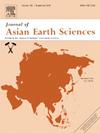Effect of extractable organic matter on nanopore structure and heterogeneity in Triassic Yanchang lacustrine shale of the Ordos basin, China
IF 2.7
3区 地球科学
Q2 GEOSCIENCES, MULTIDISCIPLINARY
引用次数: 0
Abstract
The low-pressure nitrogen adsorption and multifractal analysis of Triassic Yanchang Chang 7 shale samples, before and after solvent extraction, were conducted on the effect of extractable organic matter (EOM) on pore microstructure, porosity, and heterogeneity. Chang 7 Shale, primarily composed of type II1-II2 organic matter (OM) and argillaceous-siliceous lithofacies, is characterized by interparticle and intraparticle pores in inorganic minerals, with limited development of OM pores. After extraction, pore volume and specific surface area significantly increased from 2.91 cm3/1000 g to 4.43 cm3/1000 g and 0.61 m2/g to 1.91 m2/g, respectively. This increase is attributed to the reopening of minor pores (<23 nm) previously occupied by saturated hydrocarbons, which enhanced the proportion of minor pores and reduced overall pore heterogeneity. Saturated hydrocarbons in EOM were mainly enriched in carbonate interparticle pores, while aromatic hydrocarbons were concentrated in pyrite intraparticle pores. Resins and asphaltenes were predominantly adsorbed onto OM and inorganic mineral surfaces. Clay and pyrite intraparticle pores were nearly completely filled with EOM, reducing heterogeneity, whereas detrital mineral interparticle pores, partially filled with EOM, increased heterogeneity. A linear correlation between EOM content and Rock-Eval S1 suggests that sample crushing may lead to an underestimation of saturated hydrocarbon content in S1. These findings provide critical insights into the pore structure evolution and shale oil enrichment mechanisms in Yanchang Shale.

求助全文
约1分钟内获得全文
求助全文
来源期刊

Journal of Asian Earth Sciences
地学-地球科学综合
CiteScore
5.90
自引率
10.00%
发文量
324
审稿时长
71 days
期刊介绍:
Journal of Asian Earth Sciences has an open access mirror journal Journal of Asian Earth Sciences: X, sharing the same aims and scope, editorial team, submission system and rigorous peer review.
The Journal of Asian Earth Sciences is an international interdisciplinary journal devoted to all aspects of research related to the solid Earth Sciences of Asia. The Journal publishes high quality, peer-reviewed scientific papers on the regional geology, tectonics, geochemistry and geophysics of Asia. It will be devoted primarily to research papers but short communications relating to new developments of broad interest, reviews and book reviews will also be included. Papers must have international appeal and should present work of more than local significance.
The scope includes deep processes of the Asian continent and its adjacent oceans; seismology and earthquakes; orogeny, magmatism, metamorphism and volcanism; growth, deformation and destruction of the Asian crust; crust-mantle interaction; evolution of life (early life, biostratigraphy, biogeography and mass-extinction); fluids, fluxes and reservoirs of mineral and energy resources; surface processes (weathering, erosion, transport and deposition of sediments) and resulting geomorphology; and the response of the Earth to global climate change as viewed within the Asian continent and surrounding oceans.
 求助内容:
求助内容: 应助结果提醒方式:
应助结果提醒方式:


